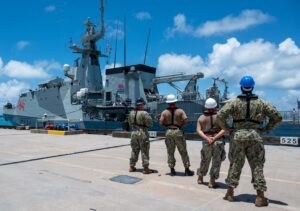Australia hosted the other two AUKUS partners in an exercise of unmanned undersea warfare technology, the Pentagon said Monday.
The U.S. Defense Department said this event was explicitly part of the AUKUS partnership and occurred off the East Coast of Australia and based on Australia’s new undersea support vessel, the Australian Defense Vessel (ADV) Guidance.

DoD said this was particularly aimed at testing equipment that can increase the protection of critical underwater infrastructure.
The ADV Guidance is meant to support undersea and surveillance systems trials. It can host a small team of sailors and both on and off-board systems, with both crewed and uncrewed capability.
The U.K.s’ Offshore Patrol Vessel HMs Tamar, on a five-year deployment to the Indo-Pacific region, also participated in the exercise. The Tamar used a combination of divers and autonomous underwater vehicles to conduct mine countermeasures operations and monitor critical infrastructure. The infrastructure includes things like communication cables and pipelines.
On Nov. 10, Australia’s Defense organization said this exercise was part of the Integrated Battle Problem 23-3 and “a range of modified commercial and military autonomous systems were deployed, in conjunction with existing capabilities, in order to test trilateral undersea warfare objectives.”
Neither the Americans nor Australians disclosed which specific unmanned undersea vehicles or technologies were used in this testing.
Adm. Samual Paparo, commander of U.S. Pacific Fleet, said in a statement that “these exercises accelerate our combined development of advanced military capabilities. In a dynamic strategic environment and the escalation of competitors’ coercive activities, AUKUS is not just about the exchange of submarines and capabilities, it is an expansion of our continued trust in and commitment to our allies.”
“We are prioritizing capabilities that improve our warfighter’s ability to see, understand, decide and act – then work together to bolster integrated deterrence,” he continued.
Paparo also underscored these kinds of trilateral exercises “develop and deliver interoperable, threat-informed capabilities key to the warfighter, and contribute to sustained defense industrial-based collaboration.”
Similarly, during a recent visit to Australia, U.K. First Sea Lord Adm. Ben Key said these exercises demonstrate advances under the AUKUS partnership as part of Pillar 2, which aims to increase cooperation on several non-submarine technologies, like unmanned systems and artificial intelligence.
“AUKUS partners are developing a suite of advanced capabilities including autonomous systems, artificial intelligence, and other key technologies for the three AUKUS nations. Pillar 2 complements trilateral efforts under AUKUS Pillar 1 to deliver a conventionally-armed nuclear-powered submarine capability to Australia,” Key said.
Vice Adm. Mark Hammond, Chief of Navy for the Royal Australian Navy, in a statement argued the war in Ukraine demonstrates that “scalable autonomous and semi-autonomous systems have the capacity to transform warfighting.”
This exercise came within weeks of two Italian corporations, Fincantieri and Leonardo, singing a Memorandum of Understanding to jointly develop systems to protect underwater infrastructure.